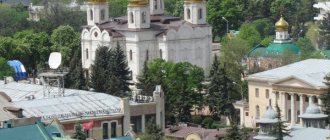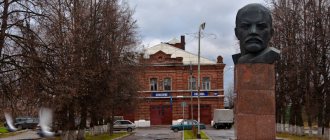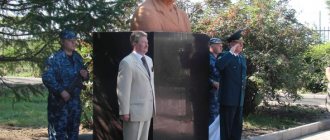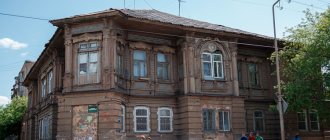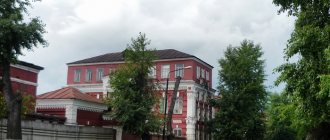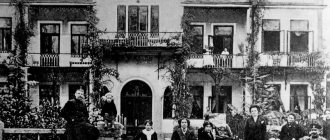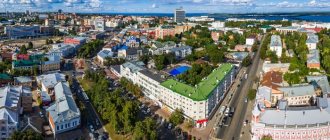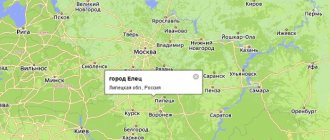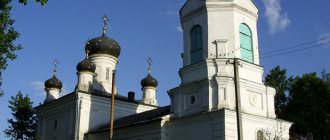The region, now called the Republic of Tatarstan, was developed back in the 8th century BC. Then the first settlements of nomads (Sarmatians) began to appear here. Since the 9th century AD, Volga Bulgaria has existed in this area, inhabited by Turkic peoples. In the 13th century, the Bulgars submitted to the Mongols of Genghis Khan, and after the collapse of the Golden Horde, an independent Kazan kingdom appeared here.
In 1552, Ivan the Terrible captured Kazan and included the kingdom in Muscovy. From that time on, the Kazan kingdom (later the province) was ruled directly from Moscow, without having its own power, like many other autonomies. In 1920, by decree of V.I. Lenin, this region became known as the Tatar Republic, in 1992 - the Republic of Tatarstan.
A convenient way to travel around Tatarstan is organized excursions from Kazan; more details can be found in this article.
Cities of Tatarstan
Kazan
Detailed guide to Kazan and its surroundings
Kazan is, first of all, a magnificent Kremlin that combines two religions (like the whole of Kazan) - the Annunciation Cathedral and the Kul-Sharif Mosque. In the vicinity of the city there is also a Temple of All Religions, which decided to unite all believers - in one building a Jewish synagogue, Orthodox and Catholic churches, a Muslim mosque, a Chinese pagoda, a Buddhist temple and other characteristic religious buildings are combined.
Chistopol
How to get there from Kazan: by bus Kazan-Chistopol from the Central bus station. Travel time is 2.5-3 hours. You can get to Chistopol by traveling by boat along the Kama.
What to see in Chistopol
A small merchant town on the banks of the Kama is the geographical center of Tatarstan. Chistopol has preserved the atmosphere of the district merchant towns. During the Great Patriotic War, it became a shelter for more than 200 members of the Union of Soviet Writers. Nobel Prize winner Boris Pasternak began writing the novel Doctor Zhivago here.
In 2014, the Chistopol State Historical, Architectural and Literary Museum-Reserve was created here.
Website: chisto-muzei.ru
What to see:
- Melnikov's House, where an art salon and a children's library are located.
- In the old mansion that belonged to the merchant A.A. Poduruev, there is an exhibition of the Museum of the county town, the pearl of which is considered to be 2 wooden bicycles, invented by a local craftsman.
- Memorial Museum of Boris Pasternak, who wrote here during the years of evacuation.
- St. Nicholas Cathedral, built with the money of the Polyakov merchants by the architect Pyatnitsky in 1838.
- Skaryatinsky Garden, which was founded in 1867 with funds from local merchants.
- Not far from Chistopol, the remains of the Golden Horde city of Dzhuketau (X-XV centuries) have been preserved.
Naberezhnye Chelny
Detailed overview of the city and its attractions
Directly opposite Elabuga is the city where the plant that produces KAMAZ trucks is located, the Nizhnekamsk reservoir and many other interesting places.
Elabuga
What to see in Elabuga
Elabuga is a county town where the destinies of many wonderful people are intertwined. Shishkin painted here, Tsvetaeva wrote, and for every famous name there are museums, memorial sites, parks and monuments.
Bulgarian
More about Bolgar and its surroundings
Near Bolgar there are the remains of an ancient settlement, an archaeological site. Temples, mausoleums, baths, chambers and palaces - all this has come to us in the form of ruins and individual stones.
Tetyushi
The most interesting things in Tetyushi and around
Tetyushi is an interesting city in itself with old buildings, but it’s even more interesting to travel next to it. For example, to Dolgaya Polyana - a place with strange energy, from where you can clearly see the Great Bolgar.
Sights of the Republic of Tatarstan
Sights of the Republic of Tatarstan. The most important and interesting sights of the Republic of Tatarstan - photos and videos, descriptions and reviews, location, websites.
- Last minute tours
to Russia
- Naberezhnye Chelny, Borovetskoye, Chulman Ave., 127
the very bestBorovets Church in Naberezhnye Chelny
Naberezhnye Chelny, Borovetskoye, Chulman Ave., 127
The Borovets Church, or the Holy Ascension Church in Naberezhnye Chelny, is an architectural monument of republican significance, protected by the state. The three-altared wooden Borovets Church, erected in 1872, later acquired stone walls.
- Elabuga, st. Embankment, 12
the very best
House-Museum of Ivan Shishkin
Elabuga, st. Embankment, 12
The great Russian artist Ivan Shishkin was born and raised in Elabuga, living here until 1852. He came from the ancient merchant family of the Shishkins, his father, Ivan Vasilyevich, did a lot of useful things for Elabuga, constantly donating funds to preserve and exaggerate its history.
- Bolgar, st. Nazarov, 67
the very best
Reserve "Bulgar Settlement"
Bolgar, st. Nazarov, 67
Founded in 1969, the Bulgarian Historical and Architectural Museum-Reserve is the oldest institution of its kind in Tatarstan. “Bulgar Settlement” is a large-scale complex of buildings erected between the 10th and 13th centuries.
- Naberezhnye Chelny, village. Hydroelectric power station, st. Central
the very best
Tauba Mosque in Naberezhnye Chelny
Naberezhnye Chelny, village. Hydroelectric power station, st. Central
Tauba (translated from Arabic as “repentance”) is a wonderful religious landmark of the old part of Naberezhnye Chelny, a mosque that organically fits into the buildings of the picturesque bank of the Kama River, but is still an architectural dominant among them.
- fabulous
Bolgar, st. Nazarov, 67
the very best
Bolgar Cathedral Mosque
fabulous
1 review
Bolgar, st. Nazarov, 67
One of the pearls of Tatarstan is the ancient city of the Great Bulgar with a huge number of architectural attractions. The Tatars have a proverb: “Whoever does not know the history of their ancestors does not feel the taste of life.” Therefore, to enjoy all its delights, you need to visit these places.
- Naberezhnye Chelny, Naberezhnye Chelny Ave., 37 A
the very best
Temple of Cosmas and Damian in Naberezhnye Chelny
Naberezhnye Chelny, Naberezhnye Chelny Ave., 37 A
There are many architectural religious monuments in Naberezhnye Chelny. In the small village of Orlovka, not leaving the city limits, there is the Church of the Unmercenary Saints Cosmas and Damian, built in 1859 - the oldest building in Naberezhnye Chelny.
- Elabuga
the very best
Devil's settlement in Yelabuga
Elabuga
You are in the Yelabuga settlement, which means you have come to visit the devil! Don't be alarmed, these are just legends. And here's what history says. In the Bulgar period, 10-14 centuries, here was a stronghold of the Bulgarians in the eastern Cis-Kama region. All that remains today is a stone tower. In 1844 it collapsed.
- Elabuga, st. Embankment
Alexander Park in Elabuga
Elabuga, st.
Embankment Today, Alexander Park in Yelabuga is a favorite vacation spot for local residents and tourists who come here. However, before it became like this, the park experienced several “ups and downs” - from its foundation back in 1856 to abandonment and vice versa. - Republic of Tatarstan, Yelabuga district, village. Ananino
Ananyinsky burial ground
Republic of Tatarstan, Yelabuga district, village.
Ananyino Ananyinsky burial ground is a unique ancient monument in its significance. It was discovered in the vicinity of Yelabuga in 1868 and is still being carefully studied. Many items found here were included in the collections not only of city museums, but also spread to other museums and exhibitions in Russia. - Republic of Tatarstan, Alekseevsky district, Bilyarsk
Bilyarsky tract "Holy Key"
Republic of Tatarstan, Alekseevsky district, Bilyarsk
This tract is a very beautiful place, which is located at the foot of the owner’s Mountain, “Khuzhalar Tava”, north-west of Bilyarsk. The source of the icon was known and revered not only by Muslims, but also by Christians and pagans. In time immemorial, a pagan sanctuary was built on the Mount of the Master. - Republic of Tatarstan, Zelenodolsk district
Volzhsko-Kama Nature Reserve
Republic of Tatarstan, Zelenodolsk district,
the Volzhsko-Kama Nature Reserve is the only one on the territory of Tatarstan and has been around for more than 5 decades. The reserve is home to one of the oldest forests in Eastern Europe; 300-year-old woody plants have been preserved here. - fabulous
Naberezhnye Chelny, village. Hydroelectric power station, Tukay embankment, 12/1
Dolphinarium in Naberezhnye Chelny
great
1 reviewNaberezhnye Chelny, village. Hydroelectric power station, Tukay embankment, 12/1
The Naberezhnye Chelny Dolphinarium is a landmark of the city, the first stationary dolphinarium in Tatarstan and the only one in the Volga region, designed for 350 spectators, an inexhaustible source of joy, unique emotions, happiness of citizens and guests of the city.
- Elabuga, st. Malaya Pokrovskaya, 20
House of memory of Marina Tsvetaeva in Yelabuga
Elabuga, st.
Malaya Pokrovskaya, 20 The House of Memory of Marina Tsvetaeva is part of the memorial complex in Elabuga, which is entirely dedicated to the famous poetess. This is the same house where Marina Ivanovna lived the last few days of her life. In August 1941, according to the distribution of the city council, she and her son received a room in the Bodelshchikovs’ house. - Elabuga, st. Maxim Gorky, 119a
Kazan-Bogoroditsky Monastery in Yelabuga
Elabuga, st.
Maxim Gorky, 119a The Kazan-Bogoroditsky monastery in Yelabuga is active today, it is for women and belongs to the Orthodox Church. It was once inhabited by many nuns, but today only about 20 novices live in the monastery. - Elabuga, st. Embankment, 14
Cathedral of the Savior Not Made by Hands in Yelabuga
Elabuga, st.
Embankment, 14 Churches and cathedrals of Elabuga deserve special attention. And even if you are indifferent to the ringing of bells and beautiful religious services, it is worth looking at these majestic buildings from the point of view of architectural and historical value. - Bolgar, Small Town
Well of Gabdrakhman
Bolgar, Maly Gorodok
There is an interesting legend associated with this well near the Volga bank. The well received its name in honor of Captain Rychkov, who studied the local region in the 18th century as part of an expedition of the St. Petersburg Academy of Sciences in search of minerals. But the locals call the well differently - “Gabdrakhman sazabe”. - Elabuga, st. Kazanskaya, 26
Elabuga Local History Complex
Elabuga, st.
Kazanskaya, 26 The Elabuga local history complex was opened in August 2007 in honor of the 1000th anniversary of the city. Today it occupies a building in the historical center of Yelabuga - an architectural monument of the 19th century, a former residential building of the merchant Nikolaev, built in the eclectic style with Baroque elements. - Bugulma, st. Herzen, 88
Bugulma Local Lore Museum
Bugulma, st.
Herzen, 88 Bugulma Museum of Local Lore, one of the oldest in the Republic of Tatarstan, was opened on October 1, 1929. The museum's exposition tells the history of the city from the moment of its inception, about the Pugachev uprising, fairs of the 19th century held in Bugulma, the Civil and Great Patriotic Wars. - Naberezhnye Chelny, Syuyumbike Ave., 44
Ice Sports Palace in Naberezhnye Chelny
Naberezhnye Chelny, Syuyumbike Ave., 44
The indoor ice sports palace appeared in Naberezhnye Chelny only in 2005, although attempts to build it were made back in the 80s. last century. Then there was not enough money, and the KAMAZ hockey team was soon disbanded. - Republic of Tatarstan, New Kyrlay, st. Central, 4
Literary and memorial complex of Gabdulla Tukay
Republic of Tatarstan, New Kyrlay, st.
Tsentralnaya, 4 The museum complex has a pleasant, landscaped area fenced with bars. This is a real garden where you can see coniferous trees, which Tukay wrote about in his famous “Shurala”. - 1
- Next pageNext
Tatarstan is very diverse, and depending on where you find yourself, you can find a wide variety of attractions.
At least on the territory of Tatarstan there are two monuments included by UNESCO in the List of World Heritage Sites. Kazan is the capital, a large and beautiful city, and this is where you need to start getting acquainted with Tatarstan. Here tourists will find an impressive Kremlin, the largest mosque in Russia and a complete immersion in Tatar culture. Today's Kazan is probably the busiest and most interesting city in the entire Volga region. A must-see is the Syuyumbike Tower, the beauty of the Kazan Kremlin, which is also one of the “Leaning Towers”; Kul Sharif Mosque; Bulgar Mosque; new Marjani mosque; National Museum with a magnificent collection of artifacts from Ancient Egypt and antiquity; Peter and Paul Cathedral; the monumental Palace of Farmers built in 2010 and the Millennium Bridge, opened in 2007. You should also definitely pay attention to the Kazan Cat on Bauman Street and the Temple of All Religions, which began to be built in 1994.
Bolgar is very interesting, where you can see the ruins of the historical capital of Volga Bulgaria, the ancient settlement of Bulgar.
Elabuga is a small cozy town, famous, firstly, for the ruins of an 11th century castle; secondly, by the fact that Ivan Shishkin was born here, and thirdly, by the fact that Marina Tsvetaeva committed suicide here. The main attractions of Yelabuga are the Shishkin House-Museum, the beautiful Kazan-Bogoroditsky Monastery and the Cathedral of the Savior Not Made by Hands; Church of St. Nicholas the Wonderworker and Marina Tsvetaeva Memorial Complex. Near Yelabuga there is a unique Ananyinsky burial ground.
Kamaevo is a small village not far from Yelabuga and Naberezhnye Chelny. Those interested in archeology should go to Kamaevo: the Old Kazan Museum-Reserve is located here. And Zelenodolsk is interesting because the famous Raifa monastery is located nearby.
In the city of Naberezhnye Chelny there is the most interesting Tauba Mosque, built in 1992. This is a rare example of the Art Nouveau style in architecture for such buildings. And since 2009, the monumental Jamig Mosque has been built in the city center.
Bolgar is very interesting, where you can see the ruins of the historical capital of Volga Bulgaria, the ancient settlement of Bulgar. At one time it was the spiritual center of Tatarstan, and to this day this place with city walls, towers and mosques remains a point of pilgrimage for Muslims from all over the former Soviet Union, who perform the “little hajj” here.
A separate destination is the island of Sviyazhsk, which is located at the confluence of the Sviyaga River and the Volga. Sviyazhsk was not always an island: it was separated from the world by the Kuibyshev reservoir in 1957. Today in the center of the island city you can see two stunning monastery complexes: the Mother of God-Uspensky and St. John the Baptist.
You should definitely pay attention to the nature of Tatarstan. In particular, the Lower Kama National Park or the Volga-Kama Nature Reserve. The latter is the only nature reserve on the territory of the republic, located in the Zelenodolsk region. One of the oldest forests in Eastern Europe grows here, and more than 2,600 species of animals live here.
Bilyarsk and Bilyarskoye settlement
All the most important things in Bilyarsk and at the excavations nearby
Bilyarsk itself, the former capital of Volga Bulgaria, is now a small village. It is interesting primarily for the remains of the former settlement, turned into a full-fledged archaeological museum. Now, in addition to the museum exhibits, you can see the remains of the city, walls, mosques, and citadels.
Tatarstan archeological monuments
Thanks to modern archaeological discoveries, you can appreciate the greatness of the ancient region and think about the amazing turns of history: even powerful, influential cities turned into ruins or lost their significance and became tiny villages and hamlets.
Bilyar settlement
- Coordinates: 54.972385, 50.403322.
Bilyar is a haven for fans of history and archeology. This large medieval city, founded in the 10th century, was previously the capital of Volga Bulgaria. In 1236, the Mongols sacked and burned the Great City.
Now in its place stands the small village of Bilyarsk, and the remains of the mighty capital lie on the southeastern outskirts of the village. Archaeologists became interested in the settlement in the 18th century; since then, scientists from different parts of the world have regularly carried out excavations in Bilyar.
Nowadays the exact plan of the city, its shape, size, and length of the rampart lines are known. Experts discovered the remains of a mosque, a feudal lord's house, a bathhouse, pottery workshops and other buildings, as well as a necropolis, household items, dishes and many other artifacts.
Kirmen settlement
- Coordinates: 55.659445, 51.143048.
The ancient Bulgar settlement near the village of Srednie Kirmeni is also known under the names Kirmen and Kermenchuk. The Bulgars built a fortress in the 10th century; later the settlement was captured by the Mongols and came under the rule of the Golden Horde.
In the 14th century, a cemetery was formed nearby, part of which has survived to this day. In 1395, Kermenchuk and three other Bulgar cities were captured by the troops of Prince Yuri of Zvenigorod. The remains of the ancient settlement have been declared a cultural heritage site of Russia.
Bogdashkinskoe settlement
- Coordinates: 54.752202, 48.800800.
In 1909, historian and archaeographer G.N. Akhmarov discovered in the vicinity of the village of Bogdashkino the remains of the medieval city of Oshel, mentioned in many ancient Russian chronicles.
In 1220, Prince Svyatoslav Vsevolodovich destroyed the city, which was never able to recover from the attack and fires and was abandoned in 1236. Traces of the citadel and defensive ramparts remain from the fort.
Be sure to see: Where to go with a child in Kazan
Ananyinsky burial ground
- Coordinates: 55.718881, 52.130232.
The burial ground near the village of Ananyino is the first example of the so-called Ananyino culture studied by scientists. It was he who gave the name to the entire archaeological culture. The burial ground was opened in 1858 by journalist Pyotr Alabin and Elabuga merchant Ivan Shishkin.
Three years later, the merchant’s son, the famous landscape painter Ivan Ivanovich Shishkin, captured the priceless find on one of his canvases. Later, archaeologists excavated the remains of settlements from the Neolithic and Bronze Age eras at the burial site. Experts discovered stone boxes, bronze celt axes, vessels, objects with images of animals and many other things.
Anthropologists examined the buried skulls and determined that the buried people were representatives of the Mongoloid race. The rich burial ground is recognized as an archaeological site of federal significance.
Ancient city of Dzhuketau
- Coordinates: 55.374432, 50.553952.
Another large medieval city near the village of Danaurovka on the banks of the Chulman River was called Dzhuketau, or Zhukotin in the Russian manner. The city was founded in the 10th century, grew, strengthened and became one of the largest fur trading centers. At one time it was the capital of the Bulgarian emirate. In 1236, the settlement was ravaged by Batu's troops.
Dzhuketau survived the raid and was able to recover, but subsequently suffered repeatedly from enemy invasions. In 1360 and 1391, the city was attacked by Russian ushkuiniki pirates, and in 1399 and 1414 by the army of Prince Yuri of Zvenigorod.
In the 13th-15th centuries, Zhukotin was the capital of the principality of the same name. In the 15th century, the city, having lost its former political and economic influence, was abandoned and eventually fell into ruins. Nowadays, archaeologists have discovered on the banks of the Chulman River not only the remains of Dzhuketau, but traces of two villages - Donaurovskoe I and Donaurovskoe II - and equally ancient necropolises.
See also the sights of the regions neighboring Tatarstan - Ulyanovsk, Samara, Orenburg and Kirov regions, the republics of Mari-El, Chuvashia, Udmurtia and Bashkortostan
The Republic of Tatarstan is one of the most tourist attractive regions of Russia. It is ideal for travel and outdoor recreation, its nature is diverse and unique, and more and more natural attractions appear on the maps every year.
Sviyazhsk Island
The most important sights of the island of Sviyazhsk
Sviyazhsk, although a village, does not deserve a separate detailed article (follow the link above). Ivan the Terrible built a wooden fortress here to capture Kazan. In order not to attract attention to the construction, all the buildings were assembled in Uglich, and then floated down the river to Sviyazhsk.
Now there are a dozen churches, cathedrals, temples and chapels and secular buildings from the 19th century left here. You can get here by boat from Kazan or by car along a causeway.
Memorial complex of Gabdulla Tukay
Address: st. Central, 4 (Novy Kyrlay village, Arsky district) Telephone: (84366) 5-67-10 Opening hours: from 8:00 to 17:00 (Monday – closed) Cost: 100 rubles – adults, 70 rubles – schoolchildren/students and pensioners, 50 rubles – children (under 5 years of age free admission)
Gabdulla Tukay is considered the founder of new Tatar poetry and his own poetic school. In the small settlement of Kyrlay, which served as an inexhaustible source of inspiration for the poet, a museum and memorial complex dedicated to Tukai was founded in the 1960s. It is housed in two buildings, next to which there are shady alleys, a flower garden and a small pine park.
In the first building, a two-story wooden house, there is a museum in memory of Gabdulla. The first floor is occupied by an exhibition, from which visitors can learn about the life and creative path of the poet. On the second floor there is an exhibition of paintings dedicated to Tukay. The total number of exhibits is 1,700; the most interesting are the personal belongings of the poet and his relatives (birth certificate, working printing press, pieces of furniture). The second house, the mansion of Sagdi (Gabdulla’s adoptive father), is occupied by an exhibition of rural life in the 19th century. It was here that the poet lived in the village of Kyrlay in 1892-95.
You can get to the complex from Arsk. Trains and buses run regularly to this city from Kazan. From Arsk itself, you should take a minibus to the village of New Kyrlay (route to New Kishet, Shurabash or Shushmabash), in its center there is a museum.
Shrines of Tatarstan
- The Kul Sharif Mosque is one of the largest Muslim temples. This is a restored copy of the mosque, which stood on this site until the 16th century, but was destroyed during the conquest of the lands by Ivan the Terrible. It took about 10 years and tons of white marble to restore the shrine.
The Kul-Sharif Mosque is the visiting card of the Muslim people of Tatarstan.
- The cathedral mosque was built in the 13th century by Khan Batu. The mosque was restored more than once after military destruction. Over many centuries, the mosque has acquired numerous legends that are worth getting acquainted with.
- The Annunciation Cathedral is one of the oldest churches in the Kazan Kremlin. During the construction of which it was the main religious center. The cathedral dates back to the 16th century and has been reconstructed more than once. With the advent of Soviet power, the Shrine was closed, and the building was used as an archive, which made it possible to preserve the ancient paintings of the cathedral walls. Now the building has been restored and again welcomes Orthodox parishioners and lovers of ancient architecture.
- The wild boar mosque was built at the beginning of the 20th century, and opened with the permission of the Leader. But it did not serve Muslims for long; after 4 years the shrine was closed, and the building housed educational institutions. Only in 1991 the building was returned to Muslims.
Now the Zakabannaya Mosque is not only a religious shrine of Muslims, but also a popular tourist attraction that can be seen freely.
- The Marjani Mosque was built in the 18th century under the patronage of Catherine the Great, who did not interfere with the religious buildings of the various peoples of the Great Empire. Since then, the mosque has grown into a major religious center for Muslims.
Near the Islamic shrine there is the Kazan Islamic College, the building of the spiritual administration of Muslims of the region, shops with Islamic literature and halal products.
- Azimov Mosque;
- Sviyazhsky St. John the Baptist Monastery;
- Raifa Bogoroditsky Monastery.
Raifa Monastery
Address: Raifa village, Zelenodolsk district Telephone: (84371) 3-47-59, (84371) 3-47-07 Opening hours: from 7:00 to 21:00 every day Cost: free
The largest operating monastery in the Republic of Tatarstan is located 30 kilometers from Kazan. It was erected after Ivan the Terrible captured the capital of Tatarstan. In 1613, monk Philaret built a cell on the shore of Lake Raifa. Gradually, Orthodox pilgrims and monks began to gather around him, and with their joint efforts they built a small chapel. In 1661, the monastery received a gift of a copy of the icon of the Georgian Mother of God, which is now the main asset of the monastery. The year 1689 was marked by a fire that destroyed the wooden buildings of the monastery, and at the same time the complex began to be built in stone. By 1708 a church was built, and by 1717 the construction of stone walls with towers was completed. The Georgian Cathedral was built in 1842, the bell tower in 1903, and the Trinity Cathedral in 1910.
Nowadays there is a shelter for orphans on the territory of the Raifa Monastery, and divine services are held regularly. An interesting feature of the lake near the complex are the “silent” frogs - they do not croak here. According to legend, the monks of the monastery prayed to God to deliver them from the sounds constantly coming from the shores of the lake (there are a lot of frogs here and now), which interfered with the performance of church singing. And to this day, no croaking can be heard near the monastery, and even the frogs brought from other places fall silent.
The monastery is located in the center of a village called Raifa Township (or simply Raifa). From Kazan you can get to the monastery by bus, which goes to Kulbashi or Urazly (the route passes very close to the object). Bus No. 405 goes here from Zelenodolsk.
What to see in Tatarstan in 1 day
Today, Tatarstan is rich in diverse attractions for tourists: from ancient burials to exquisite architectural monuments included in the UNESCO World Heritage List, which are a must-visit first.
Kul Sharif Mosque
The mosque was built with donations from townspeople, whose names are still kept in the Book of Honor. The luxurious building is named after Imam Sayyid Kul Sharif. The world-famous mosque was built at the end of the 19th century and includes 4 huge minarets 58 meters long.
The dome is located between the minarets and is decorated with a Kazan cap, and the window openings are decorated in the form of tulips. The interior spaces are richly decorated and have viewing balconies.
Address: Kazan, Sheinkman street.
Opening hours: daily, 9.00-19.00.
How to get there: take bus 74 to the Central Stadium stop.
Get directions
Kazan Kremlin
The most popular place in the capital of Tatarstan is the Kazan Kremlin. The impressively sized complex of ancient buildings harmoniously combines Russian and Tatar cultures. Some architectural monuments date back more than a thousand years.
The territory of the Kremlin occupies about 15 hectares. It contains buildings of three eras from the 10th century: towers, walls, a mosque, a Cannon Yard, a palace, a church and squares.
The Kazan Kremlin is on the UNESCO World Heritage List. Today it is the official residence of the President of Tatarstan.
Address: Kazan, Kremlevskaya, 2.
Opening hours: daily, 9.00-20.00.
How to get there: by buses 6, 15, 29, trolleybuses 1, 4, 10, get off at the stops “TSUM”, “Ulitsa Baymana”; metro station “Kremlevskaya”.
Get directions
Tower Syuyumbike
The bright gem in the crown of the Kazan Kremlin is the mysterious Syuyumbike tower. Its name is associated with Queen Syuyumbike, the devoted wife of Khan Safa-Girey, who, according to legend, chose death rather than marriage to Ivan the Terrible. She threw herself from the top of the tower, which has since leaned mournfully to the north, for which the townspeople are now famous.
The height of the tower is 58 m. From its top you can see the surroundings far away, so the Syuyumbike tower for a long time served as a watch for the city residents and was a place for defensive shooting.
Address: Kazan, Sheikman Avenue.
Opening hours: every day, 9.00-20.00.
How to get there: by metro, Kremlevskaya station.
Get directions
Farmers' Palace
A controversial and at the same time spectacular landmark of Tatarstan, which is definitely worth seeing, is the Palace of Farmers. The site is occupied by the Republican Ministry of Agriculture.
The huge luxurious building is made in a mixture of Bozar, French Baroque, Italian Renaissance, Empire and Classicism styles. The architecture of the building copies the Parisian Pati Palais.
In the evening the palace is illuminated. A 20-meter bronze tree built into the middle of the ensemble is illuminated by green lights that imitate foliage.
Address: Kazan, st. Fedoseevskaya, 36.
How to get there: take bus 89, stop “KAI”.
Get directions
Wild boar mosque
The Zakabanna Mosque was built in honor of the millennium of the adoption of Islam in Kazan. Subsequently, it became a place of pilgrimage for Muslims and a unique tourist attraction. The quadrangle of the mosque's minaret contains an octagonal pillar that turns into a luminous cylinder. The top of the building is decorated with a dome with patterned ornaments.
Carved stone window casings, unusually shaped portals, red brick walls and the Moorish style of medieval architecture give the mosque a holistic representation of the greatness of Muslim culture.
The first floor of the building contains a prayer hall, the second floor contains a teaching hall.
Address: Kazan, st. Khadi Taktasha, 26.
Opening hours: daily, 9.00-21.00.
How to get there: take bus 74, stop “Ulitsa Tufana Minnulina”.
Get directions
Kazan cat
A bronze monument to the Kazan Cat, a favorite of tourists and townspeople, is installed in the city center. A fat cat, 3 meters high, lounged on a bench. The sly man squints, scratches his stomach and twirls his mustache, looking at the mouse.
The cat became famous thanks to Tsarina Elizaveta Petrovna, who ordered several dozen hunting animals from Kazan for her palace.
Address: Kazan, intersection of Bauman and Musa Jalil streets.
How to get there: take bus 63 to the stop “Ulitsa Chernyshevskogo”.
Get directions
Alexandrovsky Passage
Built in 1983 by merchant Alexandrov, Passage was an amazing product of mixing the old Baroque style with modern engineering. The building had unprecedented achievements by those standards - an elevator, electric lighting and steam heating.
Later, the building was donated to the city, where the Palais de Cristal restaurant and the Passage theater nestled.
Address: Kazan, st. Kremlevskaya, 17.
How to get there: by bus 63 to Chernyshevsky Street.
Get directions
Mausoleum of the Kazan Khans
The burial was discovered by archaeologists in the late 70s of the last century. The contents of the crypt included the silver and leather tombs of Khan Mahmud and Khan Emin, who died in 1518. Later, the tombstones of the mausoleum, things, and the tomb itself were covered with a pyramidal glass case.
Address: Kazan Kremlin, square in front of the Syuyumbike tower.
Opening hours: every day, 9.00-20.00.
How to get there: Kremlevskaya metro station.
Get directions
House Kekin
At the beginning of the 20th century, the famous merchant Leonty Kekin built this house, betting that it would be the most beautiful building in Kazan. Architect Rush did his best, and the rich man won the argument thanks to unusual architectural solutions.
The building was built in eclectic and modernist styles. The windows, columns, and roof spiers are Moorish in style. Today the mansion contains 4 floors containing shopping complexes and offices. The courtyard is equipped for relaxation of enterprise employees.
Address: Kazan, st. M. Gorky, 8/9.
How to get there: by bus 10, stop “Tinchurina Theater”.
Get directions
Spasskaya Tower
The tower was erected in the 16th century where Tsar Ivan the Terrible planted a flag when he took Kazan. The Spasskaya Tower was built by architects who participated in the construction of St. Basil's Cathedral. The main passage of the gate of the white tower is decorated with the image of the Savior Not Made by Hands. Hence the name.
Initially, the building was laid out with a log frame covered with white lime. Two centuries later, brick quadrangles were built, decorated with a dome-tent. The clock with chimes strikes the “Crimson Ring” motif.
Address: Kazan, Kremlin, 8.
Opening hours: all days, 9.00-20.00.
How to get there: take trolleybuses 1, 4 to the stop “Ulitsa Baumana”.
Get directions
Devil's settlement in Yelabuga
Previously, the settlement was the place of formation of the Bulgarians of the eastern Cis-Kama region. The modern tract is marked only by preserved arches, windows, and ancient masonry of unprocessed stone blocks.
Two decades ago, the site was put in order: the collapsed fragments of the old tower were removed, the gates and fence were restored, and tourist paths were laid.
Tourists rush here to see the beautiful panorama of the surrounding area.
Address: Elabuga, Millennium Square.
How to get there: by minibus 1.
Get directions
Epiphany Cathedral
The main attractions of Tatarstan would not be complete without the Epiphany Cathedral. Built 4 centuries ago, the sky-blue temple is decorated with golden onion domes. Nearby is an untouched by time red brick stone bell tower with turrets, carved cornices and stars. The height of the tented bell tower is 74 meters.
Address: Kazan, st. Bauman, 78.
Opening hours: daily, 7.00-18.00.
How to get there: take bus 10 to the stop “Gabdulla Tukay Square”.
Get directions
Alexandrovsky Park
Elabuga Alexander Garden is a place where townspeople like to walk on summer evenings, and events are held. The park was founded in honor of Emperor Alexander II and is designed in the English landscape style. The center of the gardens was decorated with a theater and a fountain. Bushes and trees are not trimmed here for the sake of unity with nature. Stone winding paths are laid through thickets of juniper, pine, and old linden.
Address: Elabuga, st. Kazanskaya, 1.
Opening hours: you can visit the park around the clock.
How to get there: 30 minutes walk towards the city center or as part of a tourist group on a sightseeing bus.
Get directions
Monument to Musa Jalil
The heart of the capital of Tatarstan is decorated with an 8-meter monument to the poet Musa Jalil, beloved by the Tatar people, opened 60 years ago. The sculptor depicted the poet tearing the barbed wire of Hitler’s dungeons, which constrained the hero’s movements.
The granite wall, part of the monument complex, includes carved poems by Jalil, who was executed in Plötzensee prison.
Address: Kazan, 1 May Square.
How to get there: by metro to Kremlevskaya station.
Get directions
Marjani Mosque
The year 1767 was marked by the construction of the stone Marjani mosque, later named after the famous imam.
The unusualness of the building lies in the mixture of St. Petersburg Baroque styles with the architecture of the Middle Ages, complemented by traditional Tatar ornaments. The mosque stores a valuable artifact - the gravestone of Muhammad Gali Bey. For many years, the Muslim temple has been conducting the rituals of Nikah, Kurban Bayram, and Eid al-Adha.
Address: Kazan, st. Kayuma Nasyri, 17.
Opening hours: daily, 7.00-19.00.
How to get there: travel by buses 5, 6, 23, stop “Kayum Nasyri Street”.
Get directions
Volzhsko-Kama Nature Reserve
Address: Sadovy village, Zelenodolsk district (and surrounding area) Telephone: (84371) 34720 Opening hours: from 10:00 to 17:00 (ticket office until 16:00, closed on Mondays) Cost: 100 rubles for adults and 50 – for children in the arboretum; 60 and 30 rubles respectively – to the nature museum (excursion cost: 200 rubles – adults, 100 – children)
The Raifa Monastery is part of a large complex - the Volga-Kama Biosphere Reserve. The complex was founded in 1960 with the aim of preserving the unique natural landscapes of the Volga region. In 2005, the reserve received the status of a UNESCO reserve. Now the complex is spread over an area of 10 thousand hectares (the protected area is more than 15 thousand).
The collection of the reserve includes one of the most ancient forests in all of Eastern Europe (individual trees are up to 300 years old), 2038 species of plants, 12 of which are listed in the Red Book of Russia, 2644 species of fauna. An arboretum and a nature museum are available for visiting. In the arboretum, which traces its history back to 1921, you can see a collection of 500 species of flora (they are organized in exhibitions according to parts of the world). The Museum of Nature invites visitors to learn about the flora and fauna of the region; it contains more than 50 stuffed animals in several compositions with scenes of animal behavior.
Not far from the mentioned Raifa Monastery there is a special visitor center where tourists can watch a film about the reserve or take a virtual tour of the territory.
You can get to the reserve from Kazan by bus in the direction of Kulbashi or Bishni. The stop you need is Sadovyi.
Architectural sights of Tatarstan that are worth seeing
- The Palace of Farmers is a young building, erected in 2010. The luxury of its architecture amazes with its decoration, which is why many tourists come here to capture the Palace in a photo.
In front of the facade of the palace there is a tree cast from bronze, personifying the fertility and prosperity of the Kazan lands. Today the Ministry of Agriculture of the Republic is located in the Palace of Farmers.
You can see the attraction at any time of the day. During the day, the shine of the domes and the tree in the light of the sun will impress with their beauty, and at night, the illuminated palace has a mysterious, enigmatic beauty. City festivals, especially those related to agriculture, are regularly held near the palace. By visiting the attraction during the harvest, tourists can become more familiar with the culture and traditions of the Kazan people.
- The Kazan Kremlin is a complex of architectural attractions that is a UNESCO World Heritage Site. Which includes:
- — Eight defensive towers;
- - Governor's Palace;
- — Spaso-Preobrazhensky Monastery;
- - Blagoveshchensky cathedral;
- — Public places;
- — Kul-Sharif Mosque;
- — School of cadets;
- - Cannon yard.
- There are several exhibitions located on the territory of the complex: the Museum of Islamic Cultures, the Museum of the History of Tatarstan, the Memorial in Memory of the Great Patriotic War, and the Exhibition Center.
The history of settlement on these lands dates back to the 12-13th century, when military buildings were erected. Since the 18th century, additional structures were built on the territory of the Kazan Kremlin. You can explore the complex in only 2 days, or with a short 2-hour excursion.
- The Bulgar settlement is a complex of buildings dating back to the 10th-13th centuries. This is a whole protected complex, on the territory of which there is now a historical museum, which introduces all tourists to peoples long gone into history: the Golden Horde, Volga Bulgaria.
Among the picturesque nature you can see ancient buildings: Khan's Tomb, Northern and Eastern Mausoleums, Black Chamber, Small Minaret, Khan's Bath. Such a unique property is a world cultural heritage site and is included in the list of UNESCO sites.
Every tourist should look at the reserve complex and go back several centuries.
- Yelabuga Devil's Settlement is located on the banks of the Kama River, near the city of the same name. In Bulgarian times, from the 10th to the 14th centuries, there was a transshipment point here. Over time, the fort lost its defensive functions and time inexorably destroyed the buildings. Only the only tower survived, which suffered the same fate at the end of the 19th century. The tower lay in ruins for a long time, only part of it remained intact. Recently it has been restored and is a popular tourist attraction.
There are many legends around the Settlement; many tourists want to come and visit the “devils”.
- The Syuyumbike Tower is the heart of the Kazan Kremlin. The tower has a strong slope, which is why it is often called a leaning tower. The date of its construction remains a mystery to this day.
There are many legends and beliefs around the tower, which all tourists who come to Kazan should get acquainted with, and the incredible view from the observation deck of the nature of Kazan will impress for a long time.
- Sviyazhsk is a settlement located on the island of the same name, which is connected to the mainland zone by an embankment. A full-fledged road has been laid along the embankment to Sviyazhsk, so you can get to the island by car and by water. Anyone can freely get acquainted with the history of the city and the nature of the island.
- Alexandrovsky Passage is a luxurious building from the late 19th century. Its founder, a local merchant, planned to place an apartment building in it. At that time, in addition to the decoration and architecture, what made it super-technological was the presence of elevators, electric lighting, and steam heating.
After changing several owners, the building passed into the hands of the city, where the restaurant was located for a long time. You can look at Passage on the street. Kremlin.
Ananyinsky burial ground
Address: Ananyino village (near Yelabuga) Opening hours: 24 hours Cost: free
Not far from Yelabuga, in the vicinity of the village of Ananino, in 1858, by pure chance, one of the most significant archaeological discoveries of Tatarstan, and indeed all of Russia, was made. During the spring flood of the river located next to the village, one of the hills was washed away. As a result, ancient burials, fragments of skeletons and household items appeared. Merchant Ivan Shishkin (father of Ivan Ivanovich Shishkin, the great Russian artist) was the first to realize what had happened, and the discovery of the burial ground is attributed to him. After this, archaeologists immediately came here and began to “open up” the burial ground in an organized manner.
The burial itself was located inside a sand mound, the diameter of which was 200 meters and the height was only 4 meters. As a result of excavations, more than 1,500 objects of everyday life, weapons, cultural objects and skeletons of representatives of the past buried here were found here. At the foot, two graves of noble persons, built in the form of stone boats, were discovered. The boats were filled to capacity with jewelry and weapons. As a result of research on the mound, a new term even appeared in science - “Ananyinskaya culture”, which describes representatives of the Finno-Ugric tribes who lived in these places in the 9th-3rd centuries BC.
The village of Ananyino is almost included in the city limits of Elabuga, so almost every route from the city in this direction passes by the burial ground. Buses run all the way to Yelabuga from Kazan, Izhevsk, Naberezhnye Chelny and Nizhnekamsk. You can also get to this city along the Kama River from Kazan (by speedboat) and Nizhnekamsk (by motor ship).
Kazan
The modern capital of Tatarstan, a city with a centuries-old history filled with amazing and tragic events. Kazan took the baton of development of the region from the ancient Bulgar and carried it with honor to the present day, being at different times the capital of both the Kazan Khanate and the Kazan province. As a city with deep historical roots, Kazan is simply full of sights that cannot be seen in one or two days.
The Kremlin with its incomparable architecture of a combination of Orthodoxy and Islam, the Old Tatar Settlement with the Mardzhani Mosque, the Zilantov Monastery, the oldest Russian University and much, much more - these are all monuments dating back to the distant history of the city. And there are many more interesting museums and memorable places, amazing streets and parks. And we must not forget about modern Kazan and its new architectural objects! An ancient city that continues to develop dynamically and reach worthy milestones in economic, cultural, educational and sports terms - this is what the modern beauty of Kazan is.
Route around Kazan in 1 day
Route around Kazan in 2 days
What souvenirs to buy in Kazan
Dolgaya Polyana
Address: Dolgaya Polyana village, Tetyushsky district Opening hours: 24 hours Cost: free
The Dolgaya Polyana natural park includes the village of the same name on the banks of the Volga in the Tetyushsky Mountains. The family estate of the local Molostov family is also located here. At the beginning of the 20th century, Count Molostov brought to Dolgaya Polyana trees and shrubs unique to the area, which still grow in the area today. Examples of such species include Phrygian cornflower, steppe plum, and Andrzeevsky's carnation. Many species of the park's flora are included in the Red Book. The complex itself became a protected area only in 2000.
In addition, “Dolgaya Polyana” is considered one of the most powerful energy zones in the entire republic. Ufologists and psychics often come here for visits. Anomalous points in the park are two clearings on the way to the Volga bank. They have not been overgrown throughout the history of the complex; interference in mechanical and digital devices is observed here. At the same time, people in the clearings feel extraordinary calm, cases of wound healing and blood pressure stabilization have been noted.
You can go to Dolgaya Polyana directly from Kazan, but you will need your own transport for this. From the capital you need to move towards Buinsk, the total distance is 135 kilometers. At the entrance to Tetyushi you will see an alley of larch trees - this is where you need to turn. In addition, you can go from Tetyushi itself (to which there are buses from Kazan).
Lake Kara-Kul
Address: Bolshie Lyzi village, Baltasinsky district Opening hours: 24 hours Cost: free
Lake Kara-Kul in the Baltasinsky district can be called the Tatar Loch Ness. A local legend is associated with the reservoir, according to which a huge snake lives here. Local residents call it “su ugese”, which means “water bull”. Legends and myths have preserved for us stories about unsuccessful hunters and fishermen who disappeared in the lake area. The reason for this was the reluctance of people to make sacrifices to the owner of the lake - the snake.
In general, the name Kara-Kul can be translated as “Black Lake”. Indeed, the waters of the lake are distinguished by their blackish color (in cloudy weather, from certain points under the shade of a dense forest, the lake looks bluish-black). Perhaps this circumstance prompted local residents to think about a monster in the pond. In fact, the black tint to the water is given by the karst rocks dissolved in it, from which the shores are made.
Now Kara-Kul is ennobled. A tourist base and a boat rental point have been built here, and there are bridges along the banks. In summer, tourist rallies and other events are often organized near the lake. Fishermen love Kara-Kul for its natural resources - minnows, silver carp and carp are found here.
You can get to the lake from the villages that are located next to it. These are Bolshie Lyzi, Yarak-Churma, Nizhnyaya Sosna. A little further, 4 kilometers away is the center of the district - Baltasi, which has a bus connection with Kazan.
Beautiful places in Tatarstan that are worth visiting
Tatarstan is rich in unique and rare places that tourists should visit at least once. The republic has 132 natural monuments, including nature reserves, mountains, forest tracts, river valleys, lakes, caves, waterfalls and springs.
Volzhsko-Kama Nature Reserve
The reserve is located on a picturesque terrace on the left bank of the Volga River. The oldest forest in Eastern Europe grows here. The flora numbers 2038 species of vegetation, among which are 300-year-old trees that are long-lived. The fauna includes 2,500 species of animals. There are “Red Book” animals and plants in the reserve.
Tourists are taken along eco-trails as part of excursion groups and shown rare animals and birds.
Address: Zelenodolsk district, 52 km from the village of Sadovy.
Opening hours: Monday-Friday, 9.00-16.00, Saturday, 9.00-18.00.
How to get there: buses 404 – “Kazan – Kulbashi”, 406 – “Kazan – Bishnya”. Get off at the "Sadovyi" stop.
Get directions
Blue Lake
People called the waters of karst origin Blue Lakes. Large and attractive for tourists: Bolshoye, Protochnoye, Maloye. The area connecting the reservoirs is a protected natural monument and extends over 20 square meters. m.
Beginning diving enthusiasts prefer to train in the clear waters of Blue Lake.
Address: Kazan, Blue Lake village.
How to get there: by bus 35 to the stops “Golubyatnikova”, “Solnyshko”, then by bus 40 to the village of Shcherbakovo.
Get directions
Lake Kara-Kul
The name of the reservoir is translated as “black lake”. Old residents say that a powerful serpent lives in the depths of the lake. Previously, the disappearance of hunters was associated with him. The dark-water lake is fed by underground springs. The depth of the reservoir reaches 18 meters. There is plenty of fish, which attracts fishing enthusiasts.
The territory is landscaped and suitable for overnight stays of large groups of people. There is a rental of various types of boats, tents, and fishing gear.
Address: Baltasinsky district.
Rental operating hours: 7.00-18.00.
How to get there: 2 hours by car towards the village of Kinderi, then follow the signs.
Get directions
Yuryevskaya Cave
The kilometer-long cave was explored in 1953. The walls of the halls are overgrown with gypsum crystals and calcites. Through a narrow passage, tourists find themselves in a unique space with an unusual dark color of walls, floor, and ceiling - the “Hall of Horrors.” Other halls are smaller and white thanks to the limestone.
Address: 3.5 km from the village of Tenishchevo, Kamsko-Ustinsky district. Visiting is allowed during daylight hours.
How to get there: by bus 529 “Kazan-Kamskoe Ustye”, stop “PGT Tenishchevo”.
Get directions
Mount Chatyr-Tau
The height of the mountain is 320 meters, the length of the ridge is 7 km. The wide slopes and special topography of the mountain have become favorite training grounds for paragliders. Many come to see the beauty of the flora and fauna of the foothills, walk along mountain trails, and admire stunning views.
Address: Aznakaevsky district, Urazaevo village.
How to get there: by bus “Kazan-Aznakaevo”, then on foot or by taxi to the sign “Chatyr-Tau”.
Get directions
Bugulma Local Lore Museum
The old local history museum opened almost 100 years ago. The exhibitions tell the story of the emergence of Bugulma, the Pugachev uprising, and the life of past centuries. The highlight of the local history museum is considered to be the jewelry of Tatar women. Air forging, lightness of gold products surprises with the elegance of lines and the skill of old masters.
Address: Bugulma, st. Herzen, 88.
Opening hours: all days except Monday, 8.00-17.00.
How to get there: take trolleybus 5, stop “Ulitsa Vakhitova”.
Get directions
Yuryevskaya Cave
Address: Tenishevo village, Kamsko-Ustinsky district Opening hours: 24 hours a day Cost: by prior arrangement with the hike organizer
The largest cave in the Volga region and at the same time the only cave open to visitors in Tatarstan, Yuryevskaya, is located in the Bogorodsky Mountains. It is a regional natural monument. The first studies in the cave were carried out in 1953. Since that time, speleologists have been clearing away the rubble in the cave (in 1971 its length increased from 20 to 360 meters, in 2009 - to 507 meters).
The cave consists of a cave-in grotto (entrance), two large halls and three manholes. The first one, the Grotto of Rains, is famous for its red stalagmite half a meter high. The second - Red Grotto - has picturesque streaks on the walls, a well and a steep vertical passage. The third hole is difficult to access and closed to visitors. And in general, the entire cave is not equipped for mass excursions; access here is open only in the format of speleo tours with the appropriate equipment.
The cave is located near the village of Tenishevo, 6 kilometers from Kama Ustye. You can get to the center of the area by bus from Kazan, and from there you can go directly to the cave.
Historical places of Tatarstan
Cultural tourism in Tatarstan
Traveling to interesting places and visiting cultural sites has been popular since ancient times. The easiest way to find out a little more about what is available in your area is to book a tour from a travel company on our website. Guides offer a wide range of trips for different numbers of days and with different budgets. In addition, such a vacation can be combined with walks in nature. Whatever type of excursion you choose, you will spend your time as interesting as possible.
Experienced guides will take you inside all the monuments and buildings included in the program and tell you their history. Cultural tourism in Tatarstan has a number of advantages:
- you can visit the most interesting historical places in the region and take photographs of them;
- the opportunity to consider the history of the country in new aspects;
- a chance to organize educational, bright leisure time for yourself;
- the opportunity to explore the region;
- low cost;
- the opportunity to meet like-minded people.
It will be interesting to invite friends or relatives to visit historical places in Tatarstan. With them, emotions are brighter and more fun on the road. Also, such an excursion will be an extraordinary emotional gift. It will be able to immerse you in historical action, tell you about the heroism of your ancestors, or delight you with an unexpected ending to the story.
Nature and history are inseparable
Today, a very popular type of recreation is a trip to nature with visits to local attractions. Our guides create routes for tourists that run past famous historical monuments near natural sites. The end point of such a path can be the spacious shore of a picturesque river or lake, where you can pitch a tent and relax for several days, swimming and catching fish. This way, you will be able to see new interesting places and at the same time sleep in a tent listening to the singing of birds.
A professional guide will clearly indicate the direction of the route, indicate what attractions and advantages it contains. If you have a large company, you can develop an individual route. The guide will take into account all the client’s wishes and develop an optimal plan of action for traveling to the historical places of Tatarstan.
A trip to the sights of the region is a great way to spend time productively. Such an excursion with children is especially good - kids will be able to get to know the region better and see a lot of new things. Such tours are also popular among young people, couples and the elderly. They are interesting to everyone who likes to relax actively, and not at home on the couch, and the guides on our site are ready to help you go on such a journey.
By the way, many historical places of Tatarstan are known not only for their beautiful architecture and amazing views, but also for the presence nearby of a good spring with healing waters, according to local beliefs. In such a place you can not only learn about stories not described in textbooks, but also be inspired by the extraordinary energy of natural harmony.
Mount Chatyr-Tau
Address: Aznakaevsky district (7 kilometers from Aznakaevo) Opening hours: around the clock Cost: free
The highest point of the Republic of Tatarstan is 321.7 meters above sea level. On many maps it is marked as a ridge, but in fact the mountain is an outlier that took the form of a ridge as a result of erosion of the surrounding area, and not due to tectonic movements.
The name Chatyr-Tau is translated as “tent-mountain”, and this is logical - the remnant looks like a giant green tent. From the top of the mountain you can see a panorama of the surrounding area, as well as the settlements of neighboring Bashkortostan. In 1972, the territory of the mountain and neighboring lands became a natural monument, and in 1999 - a nature reserve. At the foot of Chatyr-Tau lives a colony of steppe bobaks and the flora of the Red Book of Tatarstan grows. The mountain is very popular among fans of hang gliders and paragliders.
Direct buses run from Kazan to Aznakaevo. From the regional center itself you will have to take a taxi (there is the option of walking or traveling as part of an excursion group).
Brief history of Tatarstan
Tatarstan is a republican political unit of the Russian Federation. The history of state formations in this territory, namely, in the Middle Volga region in the bed of the Volga, Kama, Kazanka rivers, began with the creation of Volga Bulgaria - the state of the ancient Bulgars, who came here from the steppes of the Azov region and assimilated with the local Finno-Ugric and Turkic peoples.
Volga Bulgaria
(9-13 centuries) was a large, economically developed medieval state with trade, military, and cultural relations with the countries of the West and East. Many prosperous cities were built on its territory, the fortifications of some of which have survived to this day. In the 10th century, Bulgaria converted to Islam and developed further along the path of a Muslim state. In the 13th century, after the devastating invasion of Mongol troops, known as the Western Campaign of 1236, Volga Bulgaria ceased to exist, and its lands became part of the Golden Horde as an ulus.
After the collapse of the Golden Horde, an independent feudal state was created on the former Bulgarian lands - the Kazan
Khanate
(15-16 centuries), the territory of which even exceeded the size of Volga Bulgaria. The founder of the new state formation was one of the Golden Horde khans, Ulu-Muhammad. In the Kazan Khanate, continuing the traditions of Bulgaria, agriculture, beekeeping, construction, trade, jewelry making, etc. developed.
Constant hostile relations with the Russian state, their mutual claims, attacks and devastation of territories continued until 1552, when Ivan the Terrible, as a result of a series of military campaigns, a long siege and a powerful assault using gunpowder, managed to take Kazan. The Kazan Khanate ceased to exist and territorially became part of the Russian state, which began to introduce Orthodoxy to the annexed lands. The conquered lands were controlled from Moscow, and the new entity was called the Kazan Kingdom.
, the Kazan province was established in 1708
The territory is huge in size, uniting many voivodeships: Sviyazhsk, Penza, Simbirsk, Astrakhan, Ufa, etc. The first governor was Pyotr Apraksin. The boundaries of the province were constantly changing, but its name remained in force until the October Revolution of 1917.
After the Civil War, as a result of decrees of the Soviet government, the Tatar Autonomous Soviet Socialist Republic was formed, which in the 90s of the 20th century turned into the Republic of Tatarstan.
